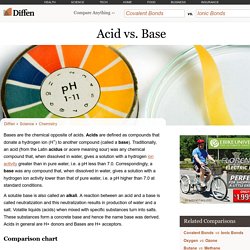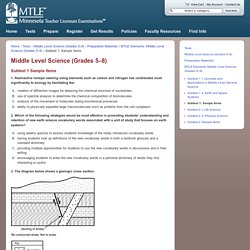

Acid vs Base. Bases are the chemical opposite of acids.

Acids are defined as compounds that donate a hydrogen ion (H+) to another compound (called a base). Traditionally, an acid (from the Latin acidus or acere meaning sour) was any chemical compound that, when dissolved in water, gives a solution with a hydrogen ion activity greater than in pure water, i.e. a pH less than 7.0. Correspondingly, a base was any compound that, when dissolved in water, gives a solution with a hydrogen ion activity lower than that of pure water, i.e. a pH higher than 7.0 at standard conditions.
A soluble base is also called an alkali. A reaction between an acid and a base is called neutralization and this neutralization results in production of water and a salt. Properties of acids vs bases Bases have a slippery feel on fingers and taste bitter. Litmus Test and Other Reactions Litmus paper is made from dyes derived from lichens; it is water-soluble, meaning it can be fully dissolved in water. References. IonicChargesChart.pdf. Laws of Thermodynamics. Acid-Base Reactions in Solution: Crash Course Chemistry #8. How-to-bohr_and_lewis-structures_ppps.pdf. Electron configurations. Vector Free Body Diagrams Part 1 Physics Lesson.
Inherited traits. How Mendel's pea plants helped us understand genetics - Hortensia Jiménez Díaz. Protein Synthesis! Plant vs Animal Cells - Differences in Organelles. DNA Replication and Protein Synthesis. Linear Motion. Plate Tectonics for Kids - from www.makemegenius.com.
Human skeletal system. The Periodic Table: Crash Course Chemistry #4. Bill Nye Lenses. The Respiratory System. Middle Level Science (Grades 5–8) Subtest 1 Sample Items 1.

Radioactive isotope labeling using elements such as carbon and nitrogen has contributed most significantly to biology by facilitating the: creation of diffraction images for deducing the chemical structure of nucleotides. use of spectral analysis to determine the chemical composition of biomolecules. analysis of the movement of molecules during biochemical processes. ability to physically separate large macromolecules such as proteins from the cell cytoplasm. 2. Which of the following strategies would be most effective in promoting students' understanding and retention of new earth science vocabulary words associated with a unit of study that focuses on earth systems?
3. According to the diagram, which of the following statements about the sequence of geologic events must be true? The top layer of shale eroded before the faulting. 4. Warm air at the top of the atmosphere flows toward cooler air at Earth's surface. MN036_PeriodicTable.pdf. MN036_Formulas.pdf. Middle Level Science (Grades 5–8)
0002 Understand connections between science, technology, and soc. 0003 Understand the content and methods for developing students' 0004 Understand the components and evolution of the Earth system. 0005 Understand matter and energy in Earth systems. 0006 Understand Earth in the solar system and universe. 0007 Understand human interactions with Earth systems. 0008 Understand the structures and functions of living organisms. 0009 Understand molecular and cellular life processes. 0010 Understand the diversity and biological evolution of life. 0011 Understand the interdependence among living things and the. 0012 Understand linear motion and forces. 0013 Understand vibrations, wave motion, and the behavior of lig.
0015 Understand the properties and structure of matter. 0016 Understand chemical reactions, thermodynamics, and chemical. How To Memorize Things Quickly & Effectively. What separates you from someone that can memorize π (pi) to the 100th decimal?

It’s not natural ability; it’s technique and practice. In this tutorial, I will teach you how to master memorization and change your life. Table Of Contents Chunking | Break the information up into smaller chunks and re-categorize it.Spaced Repetition | Exploit the spacing effect by using an SRS flashcard application.Understand Memory | Learn the 11 properties that determine the difficulty of a given piece of information.Preparation | Avoid music with lyrics. Disconnect from the internet. Hover over the to see a preview of each section. Tap on the to see a preview of each section.
Jump to Part 2 | Part 3 (Coming Soon!) 1. Did you know that there is an optimal size of information for memorization? Scientists and marketers have long known that the ideal information chunk size is approximately 3 to 4 units, and have used this knowledge to design everything around us to be easier to memorize.